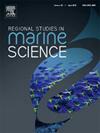Cadmium and rising tides: Amplified greenhouse gas emissions from mangrove sediment
IF 2.1
4区 环境科学与生态学
Q3 ECOLOGY
引用次数: 0
Abstract
Mangrove ecosystems, renowned for their carbon sequestration capabilities, also contribute to the emission of greenhouse gases from their sediments. They are under stress from human activities and global changes, such as heavy metal pollution and rising sea levels, which can affect carbon stability and greenhouse gas emissions. However, the combined impact of these factors is not fully understood to date. This study assessed the impact of cadmium contamination at varying levels of inundation depths on the emission of CO2, N2O, and CH4 from mangrove sediments. The findings indicated that increased inundation depth intensifies the effect of low cadmium concentrations on CO2 emissions, with sediment CO2 flux doubling from 3430 μmol m−2 h−1 to 6720 μmol m−2 h−1. In contrast, deeper water levels reduced N2O emissions in the presence of high cadmium concentrations, lowering sediment N2O flux from 14.10 μmol m−2 h−1 to 10.13 μmol m−2 h−1. These results highlight that the combined effects of rising inundation depth and cadmium pollution can enhance greenhouse gas emissions from mangrove sediments. It is crucial to consider the synergistic effects of pollution and rising sea levels on the stability of sediment carbon and gas emission rates in the conservation and management of mangroves. Such assessments will bolster efforts to protect blue carbon and achieve carbon neutrality in the future.
镉和涨潮:红树林沉积物的温室气体排放增加
以固碳能力而闻名的红树林生态系统也有助于从其沉积物中排放温室气体。它们受到人类活动和全球变化的压力,比如重金属污染和海平面上升,这些都会影响碳的稳定性和温室气体的排放。然而,到目前为止,这些因素的综合影响还没有完全了解。本研究评估了不同淹没深度下镉污染对红树林沉积物CO2、N2O和CH4排放的影响。研究结果表明,低镉淹没深度对CO2排放的影响增强,沉积物CO2通量从3430 μmol m−2 h−1增加到6720 μmol m−2 h−1。相反,在镉浓度较高的情况下,较深的水位降低了N2O的排放,沉积物N2O通量从14.10 μmol m−2 h−1降低到10.13 μmol m−2 h−1。这些结果表明,淹没深度上升和镉污染的共同作用会增加红树林沉积物的温室气体排放。在红树林的保护和管理中,考虑污染和海平面上升对沉积物碳和气体排放率稳定性的协同效应至关重要。这样的评估将加强未来保护蓝碳和实现碳中和的努力。
本文章由计算机程序翻译,如有差异,请以英文原文为准。
求助全文
约1分钟内获得全文
求助全文
来源期刊

Regional Studies in Marine Science
Agricultural and Biological Sciences-Ecology, Evolution, Behavior and Systematics
CiteScore
3.90
自引率
4.80%
发文量
336
审稿时长
69 days
期刊介绍:
REGIONAL STUDIES IN MARINE SCIENCE will publish scientifically sound papers on regional aspects of maritime and marine resources in estuaries, coastal zones, continental shelf, the seas and oceans.
 求助内容:
求助内容: 应助结果提醒方式:
应助结果提醒方式:


